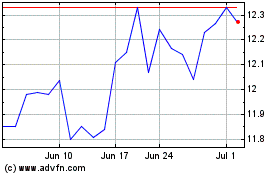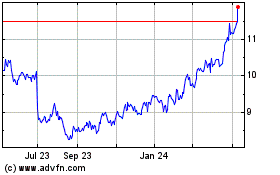By Carolyn Cui and Daniel Huang
One of China's biggest lenders is planting its flag in the
middle of Manhattan, a symbolic move for a bank with ambitions to
challenge Wall Street on its home turf.
Bank of China is preparing to move its U.S. headquarters this
fall to a new 450-foot-tall glass tower overlooking Bryant Park,
leaving the low-slung brick building on New York City's East Side
that has been its home for 35 years. The bank will occupy more than
half of the 28-story building, which it acquired for nearly $600
million in 2014.
The move reflects the bank's burgeoning business in the U.S.,
where assets soared to $78 billion last year from $12 billion in
2010, according to the Federal Reserve.
As the world's fourth-largest bank by assets, state-owned Bank
of China has quietly funded some of its country's most ambitious
cross-border deals. That included a loan to Anbang Insurance Group
Co. for its purchase of a stake in a Fifth Avenue office
building.
"We've grown so much these years," said Xu Chen, general manager
of Bank of China's U.S. branch, in an interview. "The small
building is not enough to hold all of us now."
Mr. Xu said he was attracted to both the building and its
location, which he noted was at the other end of the park from the
Bank of America tower on 42nd Street. The two buildings are "a
symbol of the economic interconnection between China and the U.S.,"
he said.
Bank of China has about 500 employees in the U.S., including 400
in New York. More than 90% of the New York staff are local hires,
though most of them are ethnically Chinese, according to the bank.
Positions in the new building will include loan officers, trade
service and clearing.
The U.S. subsidiary's general manager is from Beijing, though
other top executives like the chief risk officer and chief
compliance officer are from the U.S.
Bank of China is starting to move beyond its core business of
lending to Chinese companies. Its roster of blue-chip U.S.
borrowers includes Visa Inc., Diamond Offshore Drilling Inc. and
CME Group Inc., the owner of the derivatives exchange, according to
Dealogic.
The bank also aims to compete in some of the lucrative areas
that Wall Street firms historically have dominated, such as
corporate finance, commodity hedging and commercial-real-estate
lending, Chinese bank officials have said.
Other Chinese banks have been growing overseas, too: Chinese
bank assets in the U.S. stood at around $130 billion last year, up
from $15 billion in 2010.
Bank of China by far has been the most aggressive. According to
the bank's annual report, overseas subsidiaries accounted for 23.6%
of the group's pre-tax profit in 2015. At Industrial &
Commercial Bank of China Ltd., the country's largest lender, the
figure was 6.8%, according to the company's annual report.
Chinese bank expansion is a response to the country's slowing
economic growth. Last year, China's biggest banks posted their
lowest annual profit growth in a decade, squeezed by shrinking
interest margins and growing non-performing loans at home. Bank of
China's net profit grew by only 1.3% in 2015, down from 8.2% in
2014. The bank recently reported that first-quarter net profit rose
1.7%.
The bank's Shanghai-listed shares fell 27% over the past year,
while the Shanghai stock market index was down 16%.
One way to stabilize the bank's profit is to "do a little more
overseas, and maybe a little less at home," Chen Siqing, the bank's
president, told Chinese media in March. Mr. Xu said its U.S.
operation is one of the bank's most profitable.
Efforts to ramp up U.S. operations haven't always been easy.
Chinese banks have struggled to compete for top employee talent in
the U.S. because they are less well known and have a smaller
network of corporate contacts in the U.S. than Wall Street firms
do, the banks said.
The bank also has to adhere to stricter U.S. regulations after
it surpassed $50 billion in assets. That includes liquidity-focused
"stress testing," which could require the bank to hold more
capital.
Mr. Xu said he wasn't concerned. "Compliance is our top
priority," he said.
As its U.S. business grows, Bank of China is planning to add 100
people this year to its U.S. operations, primarily on the West
Coast, Mr. Xu said. The lender is also considering a new branch in
Houston, where many Chinese oil companies operate. An application
to open the new location has been pending with the Office of the
Comptroller of the Currency since 2014.
Bank of China's new 470,000-square-foot U.S. headquarters was
developed by the Houston-based real-estate firm Hines, which
selected Pei Cobb Freed & Partners Architects to design the
project.
The architecture firm has a long history with the bank. It was
co-founded by I.M. Pei, whose father, Tsuyee Pei, had been an
executive at Bank of China, where he pioneered its foreign-exchange
business. When the bank looked for someone to design its new
headquarter buildings in Hong Kong and Beijing, I.M. Pei got the
job.
The signature attribute of the New York tower, known as 7 Bryant
Park, is a concave, hourglass-shaped incision that runs the length
of the structure on its northeast corner, instead of a traditional
right angle.
That feature would help distinguish the property from a forest
of midtown skyscrapers, while the curved glass on the lower floors
has the effect of magnifying the park's green lawn.
The building's canteen will feature American and Chinese
cuisine. Whether that means Cantonese or Szechuan isn't yet clear,
one bank official said, "but it will be very diverse."
Although the building's 10th floor terrace offers views of the
Empire State Building to the east and the World Trade Center to the
south, the bank also wanted a respite from Manhattan's urban
jungle. Two large video screens at street level will show calming
landscapes, meant as an extension of Bryant Park's greenery. At
other times, the screens will flash scenes of busy Chinese assembly
lines, happy Chinese children and bamboo-chomping pandas.
--Keiko Morris contributed to this article.
Write to Carolyn Cui at carolyn.cui@wsj.com and Daniel Huang at
dan.huang@wsj.com
(END) Dow Jones Newswires
April 30, 2016 05:44 ET (09:44 GMT)
Copyright (c) 2016 Dow Jones & Company, Inc.
Bank of China (PK) (USOTC:BACHY)
Historical Stock Chart
From Mar 2024 to Apr 2024

Bank of China (PK) (USOTC:BACHY)
Historical Stock Chart
From Apr 2023 to Apr 2024
